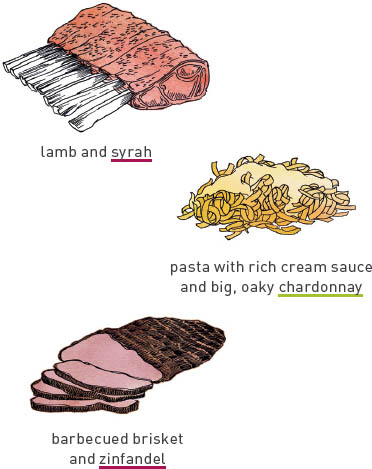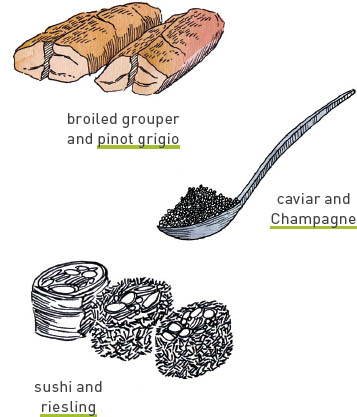
Wine experts can offer valuable insight and guidance when it comes to pairings. After all, it is their passion and profession; they can probably steer you in the right direction. (Make that a good direction.) There are no universal rights or wrongs when it comes to food and wine pairing. Even experts are subject to subjectivity. If you asked ten of the top sommeliers in the country to pick the perfect wine for a certain dish, chances are you’d get ten different, equally viable answers. Although everyone may have the same goal in mind when pairing—to create a synergy that is greater than each part alone—there are many ways to get there. Be open to suggestions from people who pair food and wine for a living, but ultimately, trust your intuition and make up your own mind once you’ve tasted a pairing. If you think it works, it does.
When there’s not a wine guru around to lean on, don’t stress over pairings. Many people mistakenly believe that they will ruin a meal if they make the wrong wine choice. The good news is that it’s virtually impossible to wreck a good meal if you select a wine that you enjoy, regardless of what anyone else says. Remember, you are the boss of your tongue. Even if you make a less than harmonious choice (it happens all the time, even to the experts), what have you really lost? Think of pairing as an endless experiment—proceed knowing that there will always be surprises. And when you do find yourself tasting a transcendent coupling, revel in it. It will be over sooner than you’d like.
All that having been said, here are some basic tips that can help guide you toward better pairings.
If you’re reading this, chances are you’ve had wine before. I’ll even go a step further and bet that you’ve had wine that you liked and wine that you didn’t like. You already have a starting point for creating pairings, and you can appreciate one of the most fundamental pairing principles: Personal preference trumps everything else. As a case in point, let’s say you adore Champagne and loathe New Zealand sauvignon blanc. If given the opportunity to taste a stellar example of both wines paired with your crab cake, you’re highly likely to deem the Champagne a better partner—even though they’re both generally considered a match made in heaven for crab—simply because of your affinity for Champagne. I would never want to encourage you to limit experimenting with the unknown, but if you’re shooting for a phenomenal pairing, consider what information you already have about who’ll be experiencing it. Knowing what you (or they) enjoy is paramount to success in food and wine pairing.
Matching intensity is the next most important part of the food and wine equation. If the balance between food and wine is off, one can overshadow the other into oblivion. If you serve a light and refreshing white wine, like pinot grigio, with pot roast, you’ll hardly be able to taste the wine. You might as well drink water; because pot roast’s deep, intense flavors will pummel the pinot grigio. On the other hand, serving the same wine with broiled grouper will give both the delicate wine and the delicate fish a chance to shine. Ultimately, you want the food and wine to be equally intense. Following are some examples of matching intensity.


One surefire way to link food and wine is to find a common flavor. If you’re starting with the food, pick out one main aroma or taste component you want to magnify and find a wine with a similar flavor. For example, a mushroom sauce on your chicken dish would likely pair well with pinot noir or Champagne; both can have an earthy, mushroomy flavor. Or you could start with the wine—say, a really fruity zinfandel—and pair it with a dish that has an echo of that fruit, like a meat dish that has a blueberry or blackberry sauce. This approach obviously works best if you already know what the wine tastes like, or have a very good idea of what it will taste like when you open it. Following are some examples of bridges.
FOOD |
WINE |
BACON |
Châteauneuf-du-Pape |
CILANTRO |
New Zealand sauvignon blanc |
NUTS |
Meursault |
LEMON |
Sancerre |
CLOVES |
oaked chardonnay |
CRANBERRY |
pinot noir |
MELON |
prosecco |
Cabernet sauvignon and other thick-skinned grapes produce wine with bitter, dark fruit flavors and mouth-drying tannin. Wines with lots of tannin find their happiest match in foods with juicy protein and fat, such as a rare steak with good marbling. Like a gift to taste buds, the proteins and fat soften the tannin, making the wine taste smooth and fruity, and tannin cuts through fat and protein, refreshing your palate.
Loads of tannin can be really icky when paired with superspicy foods, sweet foods, oily foods, or salty foods, so avoid these.
Finally, if you need pairing inspiration, look to the local cuisine of the wine region. This is much easier to do with European wine and food because they’ve grown up together, but it is possible in New World wine regions that have a gastronomic signature.
Cheese and wine are natural companions, but a little planning can go a long way in making sure their interaction is delicious. Many of the general food and wine guidelines covered in this chapter (like matching intensity and regions) apply to cheese as well. There are just a couple more things to keep in mind as you plan your cheese-specific pairings.
Youthful cheeses, like a fresh goat cheese or ricotta, go best with a young, fresh wine, like sauvignon blanc. Similarly, aged cheeses, like Parmigiano-Reggiano, can stand up to a bigger, more intense wine, like brunello di Montalcino.
For years and years, people have been pairing big red wines with cheese. Sometimes it works. But in general, white wines—with their livelier acidity—better balance the fattiness of cheese. When in doubt, choose white over red.
Blue cheeses, like Valdeón, Cabrales, Roquefort, and Stilton, are massively flavorful and rich. A first instinct is to pair them with big, tannic red wines. However, blue mold is notorious for completely stripping wines of any fruit. Dessert wines like Port, Sherry, and Madeira actually make much better partners. Their sweetness can stand up to the mold, and delectably counterbalance the salty flavors of the bluest blues.
Cheese/Country |
Milk Type |
Description |
Perfect Wine Partners |
ASIAGO |
cow |
fruity and nutty |
With young Asiago, try crisp Italian whites; with aged Asiago, try barbera, Chianti, or dolcetto. |
BRIE |
cow |
velvety soft, mushroom flavor |
Champagne and chardonnays, especially earthy versions from Burgundy, are stellar pairings. |
BRILLAT SAVARIN |
cow |
fluffy texture; milky, sour cream smell |
Champagne, white Burgundy, and chardonnays from the New World all work well. |
CAMEMBERT |
cow |
silky and creamy; mushroom aromas |
Champagne, white Burgundy, and chardonnays from the New World all work well. |
CANTAL |
cow |
butter, milk, sour cream flavors |
Rich whites, like chardonnay, or light and fruity reds like pinot noir or Beaujolais work best. |
CHEDDAR |
cow |
firm and creamy; fruity, nutty, caramel |
Zinfandel, merlot, syrah, and cabernet sauvignon are all big wines that can handle cheddar’s intensity. |
COMTÉ |
cow |
smooth but firm; sweet, salty, and tart |
Comté is great with rich, spicy whites like gewürztraminer or Alsatian pinot gris. White Burgundy also works. |
ÉPOISSES |
cow |
mushroom and meat flavors |
Rieslings, pinot gris (pinot grigio), and white and red Burgundies work best. Also try pinot noir or Beaujolais. |
FETA |
sheep or mixed sheep-goat |
salty and tangy; crumbly texture |
Crisp Greek or Italian whites are magical pairings. Also try sauvignon blanc and dry rosés. |
FONTINA D’AOSTA |
cow |
firm, smooth; herbaceous and nutty |
White Burgundy and viognier work well for whites. Pinot noir is an excellent choice for red. |
GORGONZOLA |
cow |
pungent blue; creamy texture; spicy, salty taste |
Fortified dessert wines, like Ports, Madeira, and sweeter styles of Sherry, work best. |
GRUYÈRE |
cow |
dense, firm, and smooth; hugely nutty and caramel-like with age |
White Burgundy, chardonnay, and viognier are great whites to pair with Gruyère. For red, go for an earthy pinot noir. Dry and off-dry Sherry can also be phenomenal. |
IDIAZÁBAL |
sheep |
firm; tangy, buttery, and smoky |
Earthy reds are best. Try Chianti or Rioja. |
MAHÓN |
cow |
semisoft; tangy and salty |
With young Mahón, try fruity whites like albariño, torrontés, or pinot gris. Older Mahón is best with reds. Try Spanish reds like Jumilla, Rioja, or Ribera del Duero. |
MANCHEGO |
sheep |
firm, dry; salty and tangy; nuttiness grows with age |
Spanish reds, like Rioja and Ribera del Duero, can be fabulous. Also many southern French reds, like Côtes du Rhône, work well. |
Cheese/Country |
Milk Type |
Description |
Perfect Wine Partners |
MIMOLETTE |
cow |
firm and dry; salt, caramel, butterscotch |
Buttery chardonnays are great. |
MORBIER |
cow |
creamy; mild mushroom and earth flavor |
Champagne and other sparkling wines are terrific. Also try Alsatian pinot gris and white Burgundy. |
MOZZARELLA DI BUFALA |
buffalo |
creamy, sweet, milky |
Italian whites are perfect. Also try dry rosés. |
PARMIGIANO-REGGIANO |
cow |
firm; crumbly; nutty, buttery, and meaty |
Champagne and sparkling wines are incredible. Also try Barolo, Barbaresco, or brunello di Montalcino. Merlot and cabernet sauvignon can also work well. |
PECORINO TOSCANO |
sheep |
smooth; mild; sweet milk flavors |
Crisp Italian whites are great partners. Chianti is a stellar red pairing. |
PIAVE |
cow |
firm; salty and sweet; caramel flavors as it ages |
Rich whites are best; try chardonnay or viognier. Reds with fruit will also work. Try fruity pinot noir or zinfandel. |
PONT L’ÉVÊQUE |
cow |
creamy; pungent dirty sock smell, with a milder mushroom flavor |
White Burgundy, chardonnay, and dry sparkling wines like Champagne work well. Pinot noir can also be an excellent partner. |
RACLETTE |
cow |
smooth and creamy; meaty, roasted nut flavor |
Champagne and other dry sparkling wines, dry rieslings, and Alsatian pinot gris are terrific. |
RONCAL |
sheep |
firm, crumbly, sheepy aroma, salty and tangy |
Spanish reds are a natural pairing. Try Jumilla, Rioja, or Ribera del Duero. |
ROQUEFORT |
sheep |
smooth but firm blue, with bold, spicy taste |
Dessert wines can hold their own. Try Sauternes, Banyuls, or vintage Port. |
STILTON |
cow |
creamy blue; nutty, meaty, smoky, buttery flavor |
Ports of all types are classic pairings. Also try Sherry and Madeira. |
TALEGGIO |
cow |
creamy, oozy texture; pungent smell of mushroom and meat; milder, buttery taste |
Spicy whites like gewürztraminer, grüner veltliner, and Alsatian pinot gris are the best bets for whites. Reds can also work. Try Italian reds like Barolo, Barbaresco, barbera, and Chianti. |
TOMME DE SAVOIE |
cow |
semifirm; earthy, meaty aroma; a milder flavor |
Young versions pair best with aromatic whites like riesling, gewürztraminer, and grüner veltliner. Aged versions are great with earthy pinot noir. |
VALDEÓN |
sheep or mixed sheep-goat |
creamy but crumbly; intensely salty, sharp, spicy blue |
Fortified dessert wines like Port, Sherry, and Madeira work best. |